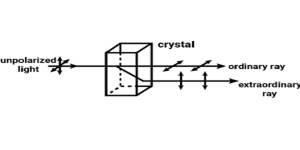Double refraction is an optical property in which a single ray of unpolarized light when entering an anisotropic medium is split in two rays, each following a different direction. One ray (called the extraordinary ray) is bent, or refracted, at an angle as it travels through the medium; the other ray (called the ordinary ray) passes through the medium unchanged. This phenomenon is also called birefringence.
This phenomenon can be observed by comparing two materials, glass and calcite. If a pencil mark is drawn upon a sheet of paper and then covered with a piece of glass, only one image will be seen; but if the same paper is covered with a piece of calcite, and the crystal is oriented in a specific direction, then two marks will become visible.
The Figure shows the phenomenon of double refraction through a calcite crystal. An incident ray is seen to split into the ordinary ray and the extraordinary ray upon entering the crystal . If the incident ray enters the crystal along the direction of its optic axis, however, the light ray will not become divided.

In double refraction, the ordinary ray and the extraordinary ray are polarized in planes vibrating at right angles to each other.
transparent crystals which are normally optically isotropic, exhibit the phenomenon of double refraction: in addition to calcite, some well-known examples are ice, mica, quartz, sugar, and tourmaline.
